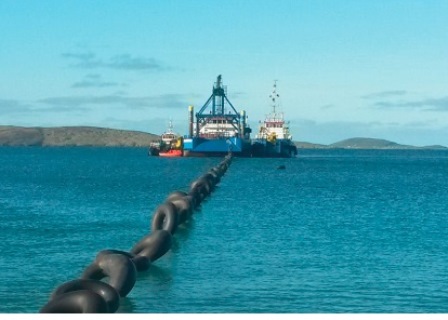Overview
About the Project
To enable the subsea cable from Shetland to connect to the GB transmission network, we have constructed a high voltage direct current (HVDC) switching station north of Wick in Caithness. The switching station connects to the HVDC system between Caithness and Moray, and will make use of capacity available in the Caithness - Moray Subsea Cable to allow onward connection to the existing onshore transmission network in Moray, with minimum new infrastructure.
The switching station allows the flow of electricity to be managed between three underground HVDC circuits - one from a converter station at Spittal in Caithness, one from a converter station at Kergord in Shetland, and one to a converter station at Blackhillock in Moray.
Video of completed switching station - November 2022
Find Out More About Shetland HVDC Link
Find Out More About Caithness - Moray HVDC Link
Why is the Project Required?
We are required to develop proposals to accommodate new sources of electricity generation seeking to connect to our network. In response to generators seeking to connect in Shetland, we have installed a new HVDC transmission cable, connecting the islands to the Great Britain electricity system for the first time. HVDC technology makes it possible to transmit electricity efficiently across the distances involved in connecting Shetland, which is located about 170 kilometres north of mainland Scotland.

SSEN Transmission trial new HVDC Robot at Caithness Switching Station - February 2024
Community Engagement
Throughout the life of our projects, we aim to work positively with local communities and keep people informed about what we are doing. This is particularly important when we are developing a proposal and we want to understand what local people think about our plans.
We endeavour to take the time to discuss proposals with local community councils, encourage engagement from the wider community and listen to the feedback we receive.
We will do our best to answer any questions and address issues or concerns that are raised with us.
When our project progresses into construction, we will continue working closely with the local community to ensure that our work has as little impact on the lives of those living and working in the area and as many long term positive effects as possible.

How we’re embracing artificial intelligence (AI)
We intend to use AI to assist our experienced teams in the analysis of your feedback, so we can categorise key points raised more quickly. You can learn more about how we’re utilising AI on this dedicated web page.
Project Updates
Project updates
Documents
-
caithness-sutherland-information-booklet.pdf
- Type:
- Date:
- 26 October 2022
- Size:
- 5 MB
-
Noss Head newsletter January 2022pdf
- Type:
- Date:
- 16 September 2022
- Size:
- 15.9 MB
-
Noss Head newsletter March 2021
- Type:
- Date:
- 16 September 2022
- Size:
- 7.1 MB
FAQs
FAQs
Recite me
To make use of this function please click on the 3 'A's' button at the bottom left of the website.






